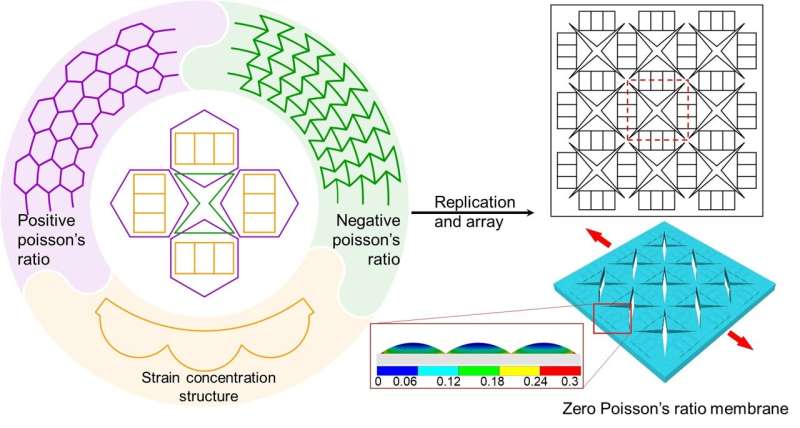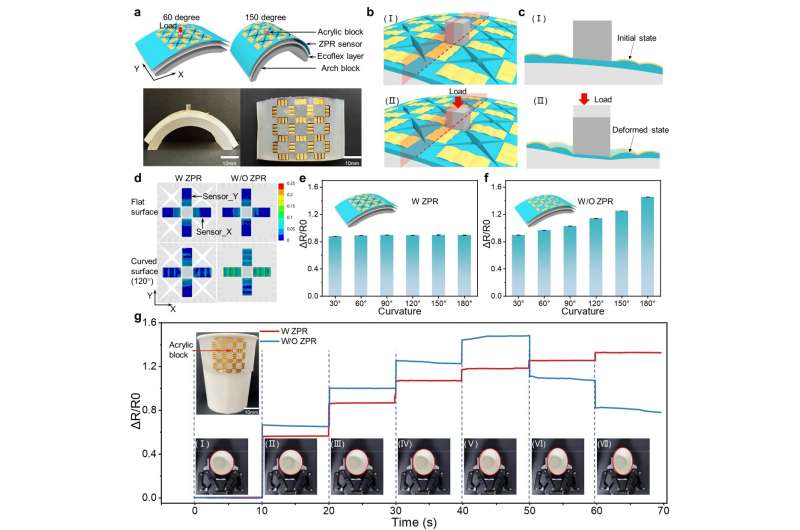This article has been reviewed according to Science X's editorial process and policies. Editors have highlighted the following attributes while ensuring the content's credibility:
fact-checked
trusted source
proofread
Flexible sensors with zero Poisson's ratio

Although flexible sensors have gained a surge of exotic sensing capabilities in the past decade, the complex deformation, which usually results from forces or strains from multi-axes, can be challenging to measure due to the lack of independent perception of multi-axial stimuli.
The Poisson's effect of sensing materials is the main obstacle for independent perception of biaxial stimuli. Researchers noticed that zero Poisson's ratio (ZPR) materials, which maintain constant transverse width under longitudinal strain, may address the interference issues in biaxial or multi-axial stimuli perception.
It's a great challenge to prepare zero Poisson's ratio elastomer membranes due to the incompressible property and nearly 0.5 Poisson's ratio of elastomers.
This study was led by Prof. Hao Wu (Flexible Electronics Research Center, State Key Laboratory of Intelligent Manufacturing Equipment and Technology, School of Mechanical Science and Engineering, Huazhong University of Science and Technology). Prof. Wu and his student Dr. Xin Huang thought that combination of traditional positive Poisson's ratio (PPR) structure and negative Poisson's ratio (NPR) structure may be an effective way to achieve zero Poisson's ratio structure.
The team found that the Poisson's ratio of hybrid structure was the superposition of the Poisson's ratio of individual structures. "The feature size of PPR and NPR structures represents the proportion of PPR and NPR on the overall Poisson's ratio, and the change of feature size and width of the hybrid structure can vary the Poisson's ratio between positive and negative," Wu says.

The researchers utilized finite element analysis to estimate the Poisson's ratio of the hybrid structure and found the optimal parameters to obtain the ZPR membrane. The PDMS membrane with hybrid structure exhibited a small Poisson's ratio of 0.07, while the PDMS membrane without hybrid structure exhibited a Poisson's ratio of 0.43, indicating the effect of the hybrid structure in decreasing Poisson's ratio.
The flexible sensors based on the ZPR membranes could accurately detect uniaxial stimuli and independently detect biaxial stimuli. When the flexible sensor was uniaxial stretched, electric resistance of sensing units along the stretching direction increased linearity, while the resistance of sensing units perpendicular to the stretching direction exhibited little increase regardless of the tensile strain.
Sensing units along a particular axis only responded to tensile strain in the corresponding axis, which endowed the flexible sensor with the capability of independent detection of biaxial stimuli.
The ZPR flexible sensors have the capability of accurately detecting force, strain, and motion status in cases of robotic manipulation and locomotion with complex deformation. Specifically, the ZPR flexible sensors can accurately measure contact forces between rigid manipulators and grasped objects regardless of the deformation of grasped objects.
Combination of two perpendicular sensing units in the ZPR flexible sensors attached on fingers of manipulators can indicate the normal bending of fingers and unexpected collisions with obstacles. ZPR flexible sensors also have the capability of detecting locomotion distance and direction of the biaxial soft robot. "The exotic sensing capabilities of ZPR sensors have great potential for applications in health care, human-machine interfaces, and robotic tactile sensing," Wu says.
The research is published in the journal National Science Review.
More information: Xin Huang et al, Flexible sensors with zero Poisson's ratio, National Science Review (2024). DOI: 10.1093/nsr/nwae027





















